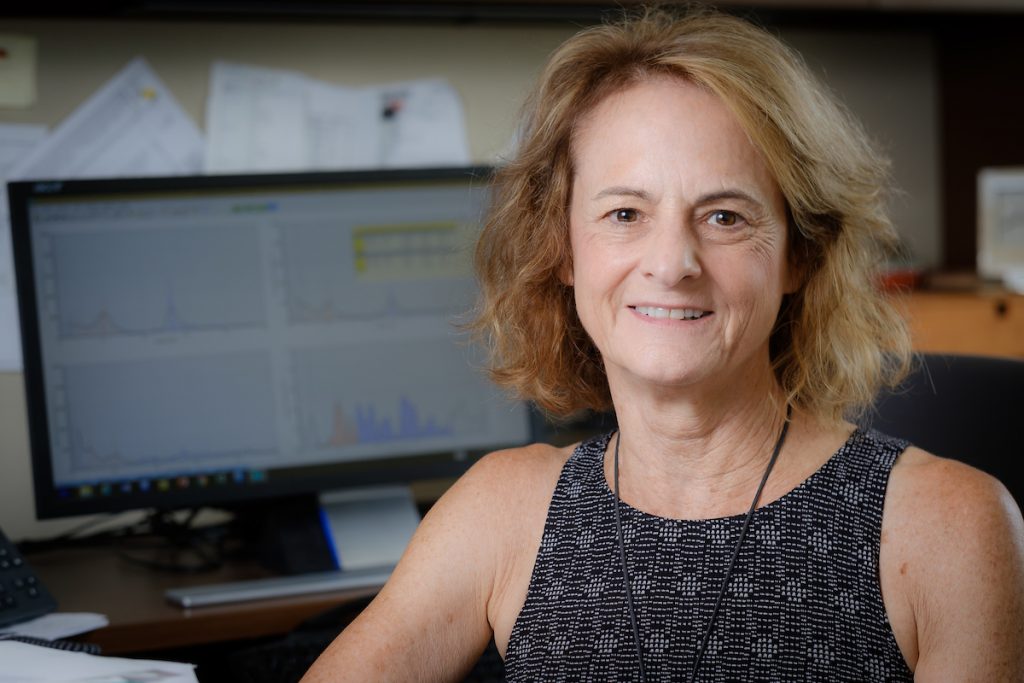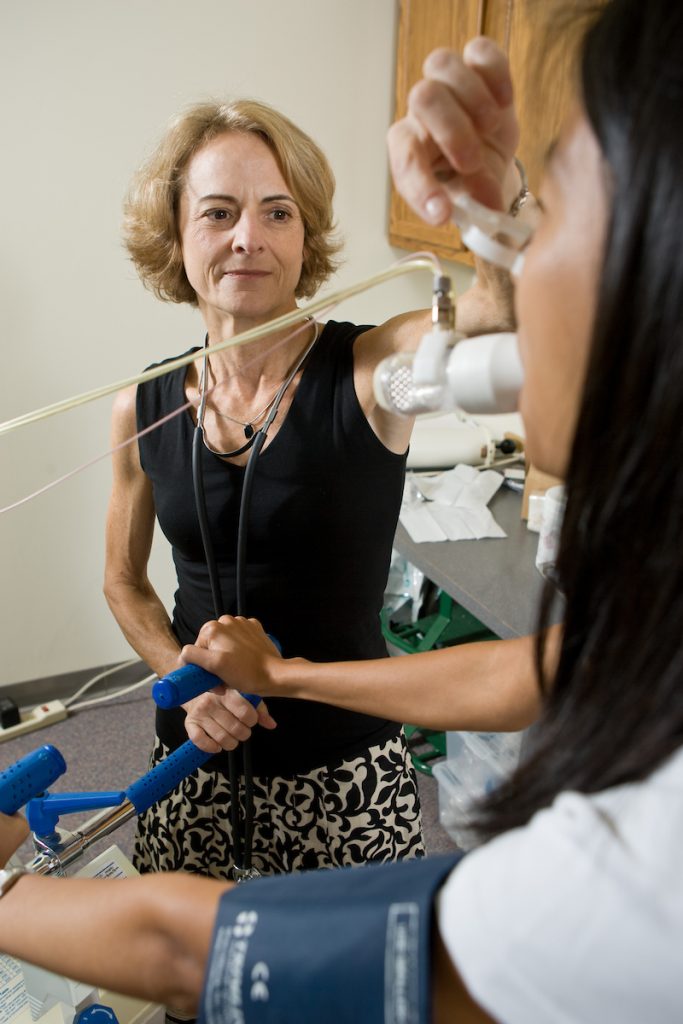Teacher-Scholar Legacies: Pat Nixon

By Shannon Mihalko, Professor of Health and Exercise Science
It was 1999, when Dr. Paul Ribisl, then-Chair of the Department of Health and Exercise Science, reached out to his undergraduate alma mater to ask Dr. Patricia “Pat” Nixon to take a chance and visit Wake Forest University. Pat had already become an internationally recognized leader in her field of pediatric exercise science, with publications in prestigious journals such as the New England Journal of Medicine, and Dr. Ribisl had hoped the Department of Health and Exercise Science’s desire to build an emphasis in public health would interest her. Also working in his favor was the snowstorm that Pat left behind at the Children’s Hospital of the University of Pittsburgh; 32 degrees and snow turned into 70 degrees and sunny as she stepped off the plane in North Carolina to what was the start of a bright future at Wake Forest. It’s telling that Pat’s first response when asked “What made you want to come to WFU?” was simply, “The weather,” before quickly adding, “and the opportunity to continue my work in clinical pediatrics research.” It was this desire to work with potential colleagues at the medical school and the opportunity to engage with dedicated students — along with the ever-constant “spring weather” Dr. Ribisl promised her — that sealed the deal. And so began Pat’s 22 years of rewarding collaborations with both faculty and students at Wake Forest University.
Pat was recruited not only for her expertise in exercise physiology, but also to help expand the department’s interest in public health. Although Pat had only taught a few classes during her tenure at Pittsburgh, she was eager to work with students and developed a new core course in epidemiology that has since grown into a senior capstone experience. From pulmonary disease to obesity and now the risks associated with the coronavirus, Pat’s students have benefitted from her passion for research design, methods, and the “Famous EPI Table.”
Her efforts did not go unnoticed, and in 2014, she was asked to lead the Health Policy and Administration interdisciplinary minor. As its Director, she is responsible for advising all HPA minors and meeting with each senior to discuss their research interest along with their professional goals. Based on these conversations, she reaches out to colleagues at the medical school to arrange an internship that best meets the students’ needs.
Between teaching epidemiology and directing the HPA minor, Pat has worked with countless students to launch them into graduate programs and careers in public health. Jonathan Miao, a 2020 Health and Exercise Science alum, commented, “Her inspirational mentoring showed me the importance of health promotion and disease prevention and engaging with experts from diverse backgrounds to address pressing public health concerns in our society. I am very grateful for her continued support and guidance on my academic and professional journey.”
Pat’s undergraduate mentoring was recognized in 2017 with the URECA Faculty Research Mentorship Award. Dr. Tim Brady, one of her HES Honors research students who is now a pediatrician in Winston Salem, wrote, “When I approached Dr. Nixon and asked to work with her, I thought it would be a long shot, but what followed was, without a doubt, one of my most memorable experiences at Wake.” When asked about her work with students, Pat humbly commented that she could not have done her research without the students, both undergraduate and graduate students, and that this work was always mutually beneficial.
“From pulmonary disease to obesity and now the risks associated with the coronavirus, Pat’s students have benefitted from her passion for research design, methods, and the ‘Famous EPI Table.’”
Shannon Mihalko, Professor of Health and Exercise Science

This sentiment was echoed by her former graduate student, Dr. Lanay Mudd, who is now the Program Officer for the Clinical Research Branch of the National Center for Complementary and Integrative Health at the National Institutes of Health. “I have been fortunate to have excellent mentors throughout my education and career that invested in both my professional and personal life. Pat Nixon stands out as the mentor who really set me on my career path – I can truly say that I would not be where I am today without her! Pat’s love of science and learning was simply infectious. I learned hands-on from her how to conduct research studies – from collaborating with others, interacting with participants, collecting, cleaning, analyzing and interpreting data, and presenting results. She was excited about every part of the process and taught me how to enjoy each step towards discovery,” Lanay said. She recalled fondly how the two would have “running” meetings together, where they would meet for a jog to discuss an array of topics, from Lanay’s thesis to her classes, next steps in her career, or life in general. “I never realized how much got accomplished on a 3-mile run around campus. Through these running meetings, she became a good friend as well as mentor to me. I still remember the final 5K race we ran together my last summer at Wake Forest; we both medaled in our age divisions (even though we are not fast runners)! She emphasized the importance of personal success and joy just as much as professional/scientific success in life for all her students,” Lanay said.
Pat’s research in pediatric exercise science has paved the way not only her students, but also for her research participants: children with chronic lung disease and those born with very low birth weight. Working with her research colleagues in neonatology at Wake Forest Baptist Medical Center, Pat is a valuable member of the research team whose work entitled “Prenatal Events Postnatal Consequences (PEPC Study I and II)” has been funded by the National Institutes of Health for many years. She is well-respected among her peers and her contributions to the field were acknowledged by both the Distinguished Alumni Award in the Department of Health and Physical Activity at the University of Pittsburgh and by being elected to serve as the President of the North American Society for Pediatric Exercise Medicine. While the data collection phase of Pat’s research career winds down, she has plenty of results still in need of publishing to keep her busy.
What brought Pat to Wake Forest more than 20 years ago was her dedication to clinical research and the opportunity to engage with students in a meaningful way that would enhance their education and give them hands-on research experience. What has kept Pat at Wake Forest since then has been her connections with colleagues, both outside and within the Department of Health and Exercise Science. When asked about the department, Pat paused and then said, “My colleagues are serious about their work and their obligations to scholarship and teaching … but also not so serious when it comes to comradery and support of each other both at work and off campus. We have fun together!”
As she looks to her retirement, Pat hopes to stay close with the lifelong friends who she has made during her time at Wake Forest, with the added benefit of “doing anything I want!” Does that include more New England Journal of Medicine articles, Pat? Perhaps this also means spending more time hiking, gardening, and tinkering with little projects around the house while staying physically active walking her 145-pound dog, Tucker, at her mountain house in West Jefferson, too.
Those of us in the Department of Health and Exercise Science are so grateful for all that Pat has done for our field and for Wake Forest University. Although we will miss seeing her in the office, we look forward to spending time with her and raising a glass or two to her retirement, successes, and our forever friendships.
“I learned hands-on from her how to conduct research studies – from collaborating with others, interacting with participants, collecting, cleaning, analyzing and interpreting data, and presenting results. She was excited about every part of the process and taught me how to enjoy each step towards discovery.”
Dr. Lanay Mudd, former student and Program Officer for the Clinical Research Branch of the National Center for Complementary and Integrative Health at the National Institutes of Health

